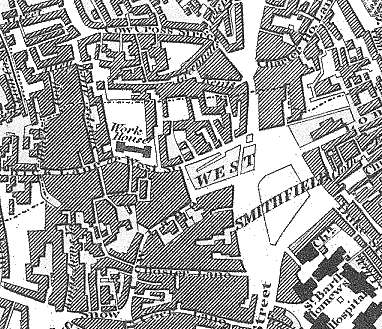St Sepulchre, Middlesex, London
Up to 1834
The parish of St Sepulchre had two districts, or liberties. One of these, St Sepulchre's without Newgate (also referred to as St Sepulchre within), formed part of the City of London; the other, which lay in the county of Middlesex, is someteimes referred to as St Sepulchre Middlesex. Both districts set up new workhouses in 1727-8 as recorded in the 1732 edition of An Account of Several Workhouses....
The workhouse for St Sepulchre without Newgate was described as follows:
A House was built on a piece of Ground joining to the Burying-Place of the Parish 1727, in Chick-Lane near Smithfield, which at present maintains
14 Men, generally sick or lame.
56 Women, many of which are old and infirm.
25 Boys.
19 Girls, which, with the Master and Mistress, make 116 in Family.
The Men and Women that are not capable of other Work, are employed in picking Ockam, the Junk is bought at Wapping for 7 s. per Hundred, and when picked is sold for 10 s. and at this Rate, betwixt 2 and 3 Tun employs about 20 infirm People all the Year round.
The rest, who are not employed in keeping the House clean, and nursing, spend their Time in spinning Jersey, which keeps about a Dozen Wheels constantly going.
The Wool ready prepared for spinning, is bought of Mr. Pickergill, Master Spinner of London Workhouse, at 14 d. per Pound, and when spun up, is sold for 8 d. or 10 d. Profit per Pound, to a Calimancoe Weaver in Spital-Fields.
A good commodious Brick-House was built out of the Poors Rate ; but notwithstanding the Charge of purchasing the Ground and Building, the Managers have been so frugal as to reduce the Poors Rate 1/3 of what it was before the Parish-Poor were brought to live in one Family.
Prayers are read every Day in the House, and among other Collects, one drawn up for their Use, by the Reverend Minister of the Parish, being prudently adapted to Persons under their Circumstances, is now printed and used in several Workhouses in and about London.
The workhouse for St Sepulchre, Middlesex, was described as follows:
A House was built in Sharp's Alley near Cow-Cross, and opened Lady-Day 1728, for all the Poor in this District which now receives, and wholly maintains about 50 Old and Young.
A Parcel of old Houses, in a very dirty part of the Parish, are pulled down, and a clean, commodious Brick-House erected in the Place, where the Helpless Aged, and young Fatherless and Friendless, are happily provided for by the Care of the Overseers of the Poor.
Most of the Family consisting of such as are weak and infirm, their chief Employment is to help one another, to teach the Children to read, and to keep the House clean, under the Direction of a Master and Mistress.
The Reverend Vicar of the Parish frequently visits both these Houses, to see that they do not neglect their Duty to God, while under the Infirmities of old Age, Poverty and Sickness, they enjoy so happy a Retirement.
The two workhouse locations were very close together — Sharp's Alley ran to the north of Chick Lane (later known as West Street). One of the workhouses can be seen on the 1820s map below. Sharp's Alley was the narrow lane running north-south at the west of the workhouse. The faint dotted line marks the line of the London wall.

St Sepulchre workhouse site, 1820s.
St Sepulchre (Middlesex) obtained a Local Act in 1772 For the Better Relief and Employment of the Poor. In 1776, the workhouse housed up to 20 inmates. The able-bodied were employed in winding silk, as were the children, who also stripped quills.
In 1776, the St Sepulchre without Newgate workhouse could house 279 inmates. In 1798, the parish promoted a Local Act (38 Geo.3 c.34) to rebuild the workhouse which was described as being "old and ruinous, and too small for the accommodation and relief of the poor." A further Act in 1806 (46 Geo.3 c.16) was passed to raise more money to complete the rebuilding.
After 1834
In 1837, St Sepulchre Newgate became part of the new West London Poor Law Union which took over the West Street workhouse.
After 1834, St Sepulchre (Middlesex) initially continued operating as a Local Act parish but in 1845 joined the Holborn Poor Law Union. The Sharp's Alley workhouse was then closed and the building was demolished in the early 1860s when the Metropolitan tube line was extended.
Records
Note: many repositories impose a closure period of up to 100 years for records identifying individuals. Before travelling a long distance, always check that the records you want to consult will be available.
-
The
Ancestry UK
website has two collections of London workhouse records (both name searchable):
- Westminster workhouse records are available on FindMyPast, .
- London Metropolitan Archives, 40 Northampton Road, London EC1R OHB.
Bibliography
- Higginbotham, Peter Workhouses of London and the South East (2019)
Links
- None.
Unless otherwise indicated, this page () is copyright Peter Higginbotham. Contents may not be reproduced without permission.


